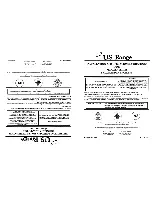
Page
9
7.3 Boiler connection to the smoke duct and chimney
The boiler connection to the flue duct and chimney must correspond to the relevant standards and regulations and must
be approved by the relevant Chimney Authorities.
Smoke duct
The smoke duct must issue into the chimney vent. Unless the boiler can be connected directly to the chimney vent, the respective
extension to the smoke duct must be as short as practicable. However, adequate heating surface longer than 1 m must be
provided and it must rise towards the chimney. The smoke ducts must be mechanically firm, sealed against infiltration of flue
gases and cleanable on the inside. The internal cross section of the smoke duct must not exceed the internal cross section of the
chimney flue and it must not be tapering toward the chimney. Use of a greater quantity of smoke knuckles is not recommended.
Smoke ducts must not be conducted through other residential or utility units.
The method of executing the passages of the smoke duct though structures made of combustible materials are given in Annexes
2 to 3 to the
Č
SN 06 1008 standard, and are mainly suitable for mobile devices, wooden weekend houses, etc.
Chimney
The chimney must be designed for such a size as to ensure that the chimney vent develops adequate draught at all times and
safely removes the flue gas into the atmosphere. We recommend that the vent be lined.
Indicative chimney dimensions recommended for ECOMAX boilers:
20 x 20 cm
min. height 7 m
15 x 15 cm
min. height 12 m
diameter 20 cm
min. height 8 m
In the event of an excessive chimney draught (the chimney draught automatically lifts the primary air flap allowing the boiler
to burn even after the fan has been put out), the proper functioning will call for installation of a draught controller.
The exact chimney size and structure determination is determined by
Č
SN 73 4201 and
Č
SN 73 4210.
7.4 Boiler connection to the power grid
The boilers must be connected to the 230 V / 50 Hz power grid by a network cord and a plug. The socket connection must
conform to the applicable
Č
SN standards.
An unprofessional intervention in the electric wiring of the boiler will result in the latter becoming damaged and may
lead to fatal injuries!
8. Operating and maintaining the boiler
Prior to commissioning the boiler, the present boiler operation and maintenance manual must be read carefully through; where
a boiler with electronic controls is being commissioned, the relevant manual covering the electronic controls must also be carefully
read through.
8.1 General principles
•
Bearing in mind the safety of all users of the system, read carefully through the present safety precautions and follow
them.
•
Prior to using the system, become familiar with the User Manual and adhere to the recommendations indicated therein.
Use the equipment exclusively for the purpose for which it is intended using the method described.
•
The elements of the system are powered by grid voltage. When handling these elements, pay attention to your safety
and protect yourselves against electric shock injuries. Do not handle the system elements with your hands wet and
protect the equipment against contact with liquids. Penetration of water, other liquids or foreign particles into the
elements of the equipment may cause serious malfunctions with its short circuits and leakage currents with severe
implications for user safety and functioning of the control or heating system.
•
The users must not uninstall any system elements. Some system elements are powered up by grid voltage – risks
of electric shock injuries.
•
If any part of the equipment falls down, allow the instrument to be checked by a professional before putting the same
back into operation. Damage not visible to the naked eye may too jeopardise user safety.
•
Do not use system elements that exhibit the signs of damage.
•
When cleaning or maintaining the elements, do not use combustible liquids, their use may lead to emergence of fire.
•
Use original accessories or accessories specified by the manufacturer only.
•
Al parts of the equipment must be positioned and kept out of reach of children and toddlers; prevent their being damaged
accidentally by children. Damage to an element may lead to a severe injury of the child.







































